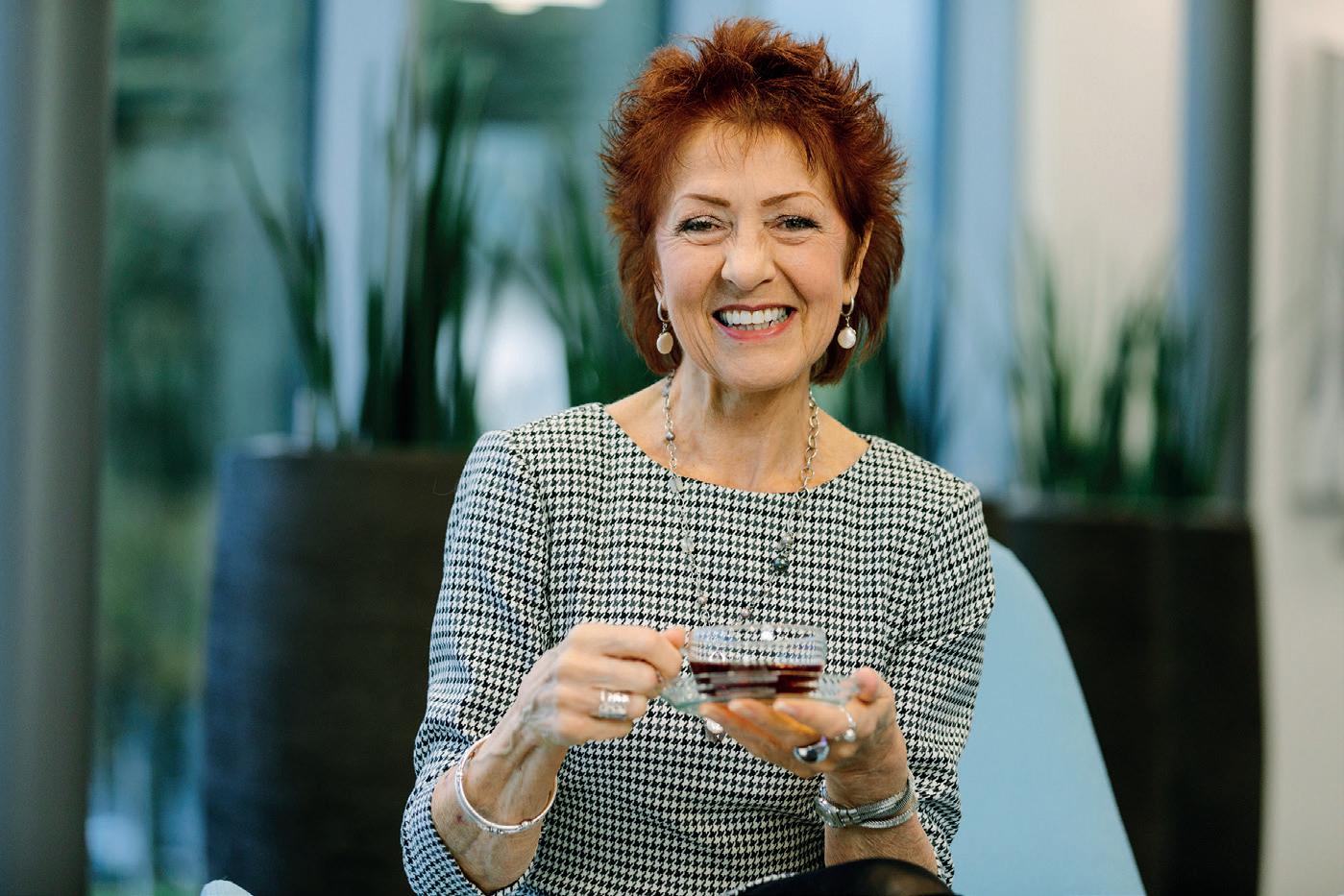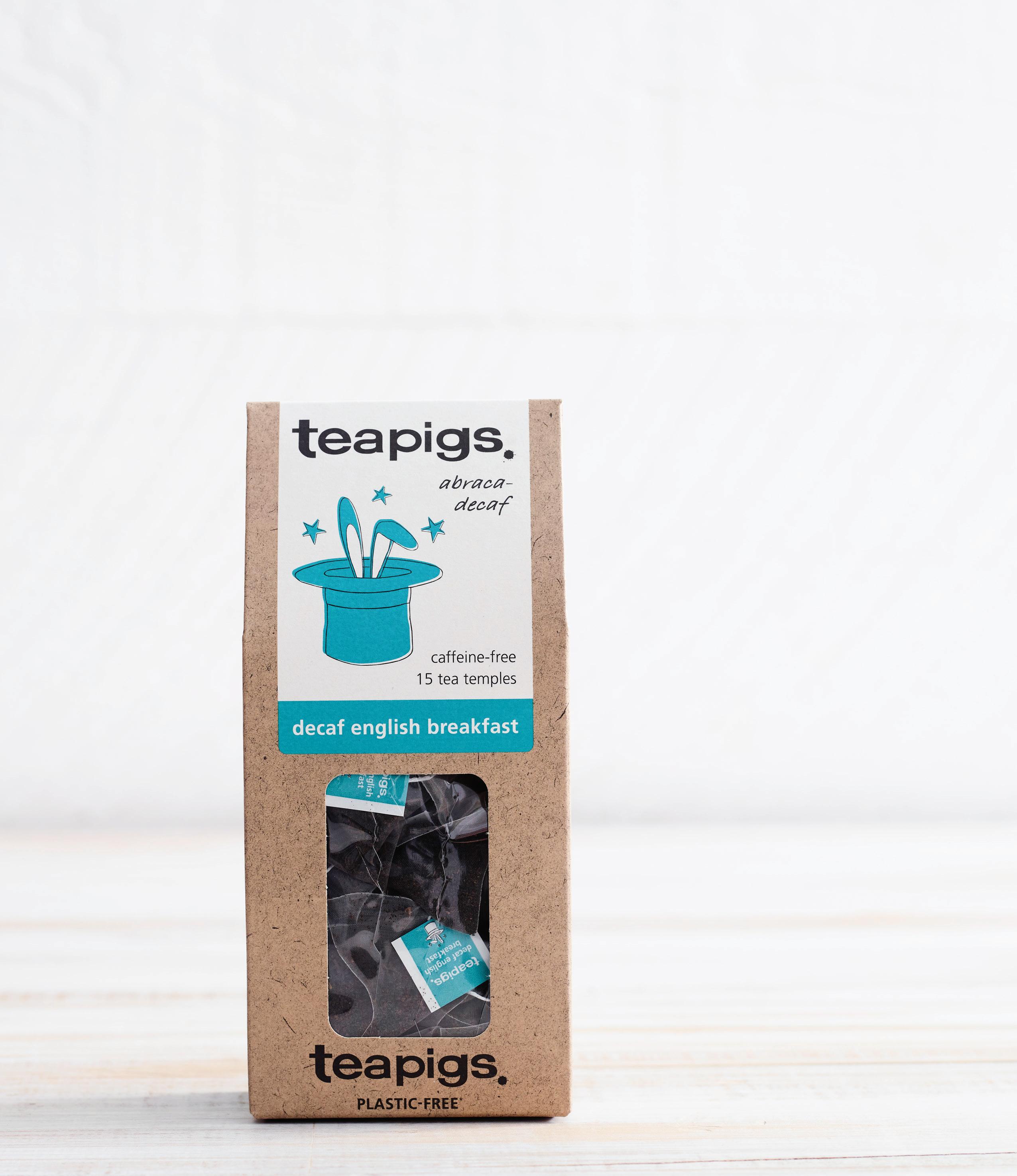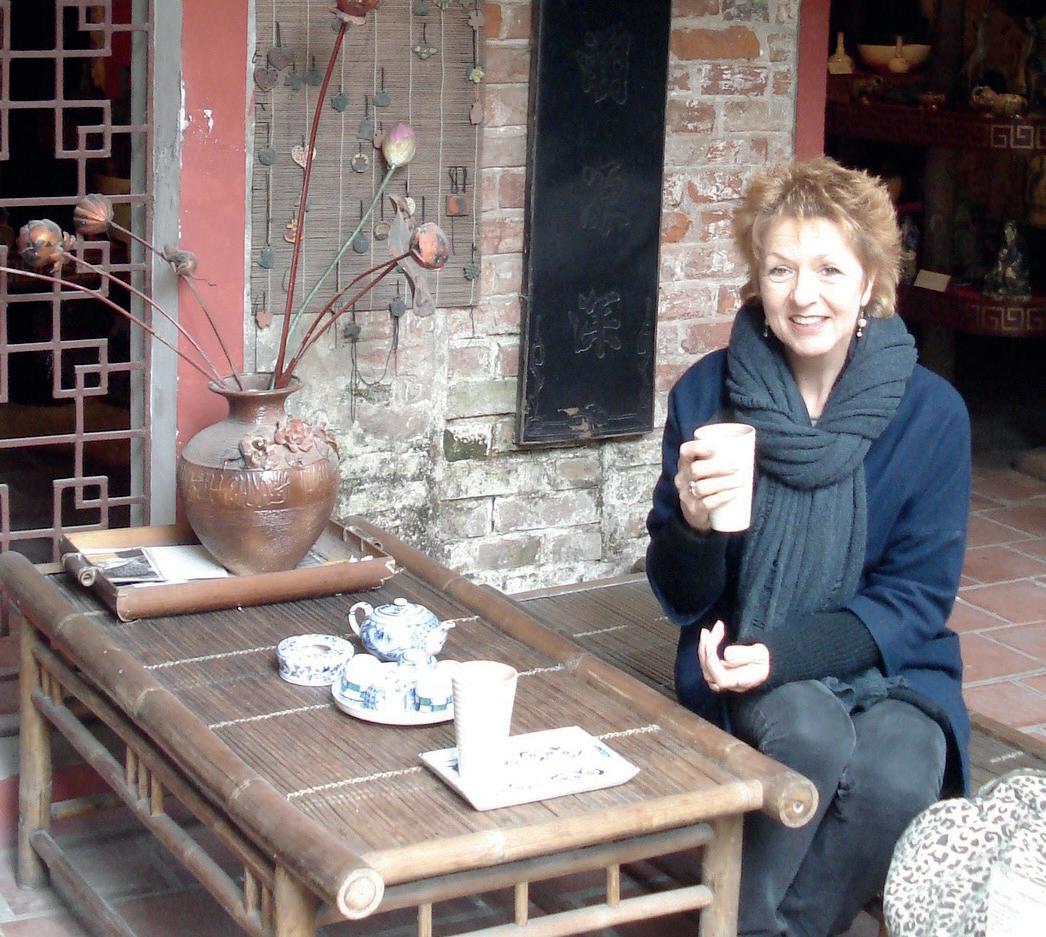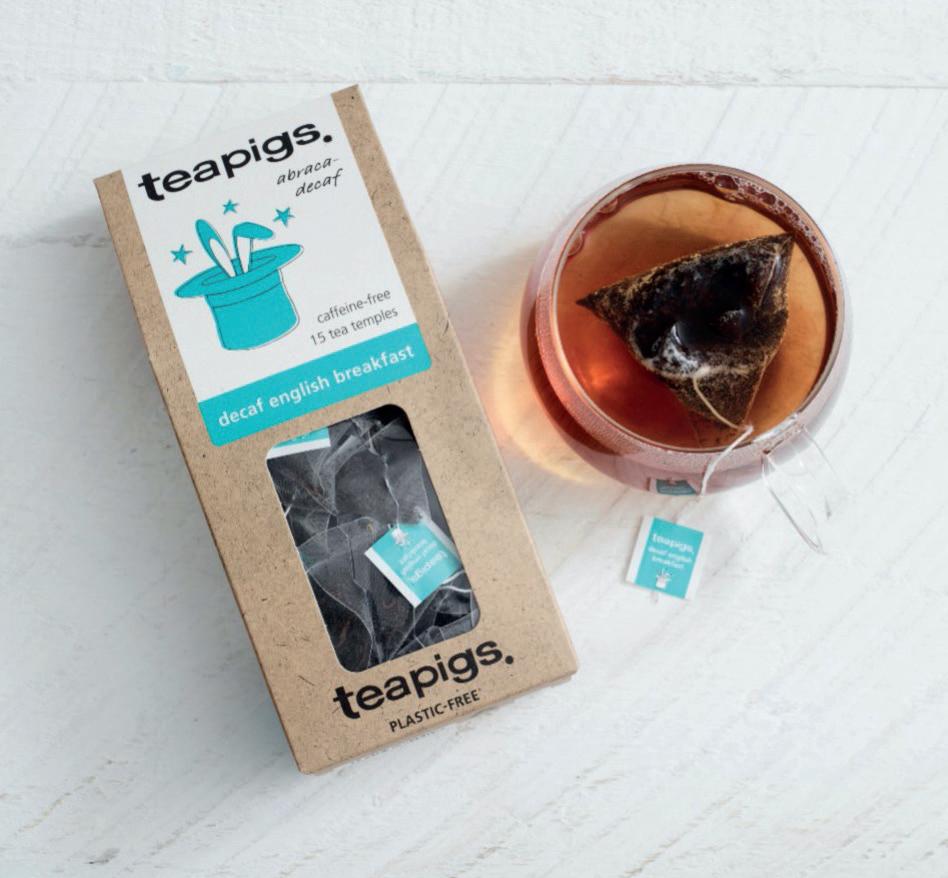
14 minute read
Tea – the drive for a
Tea
Many cafés and coffee shops, as well as other hospitality venues, are still not giving tea the attention it deserves, yet the fl avour opportunities and commitment on the part of the sector’s suppliers is there to be capitalised upon.
TOP SPOT
With over 180 years of experience, Tetley claims to be the number one tea brand in the foodservice sector (according to Salesout excl. Booker MAT data to January 2022).
“At Tetley, we are dedicated to providing support and product solutions to cafés in the UK. A wide range of tea blends, including black, green, fruit and herbal and speciality blends, helps ensure cafés cater to a broad range of customers and dayparts,” says Sebastian Michaelis, Tetley tea master (main picture).
“With a renowned fi ve-year training programme recognised by the tea industry worldwide, most of our tasters, including myself, start in the company as a graduate trainee. Our job is to taste thousands of teas every week in order to grade them using our special in-house tasting language, and to ensure that the Tetley blend is consistent and balanced despite variations in tea quality.
“We can achieve the same Tetley taste using a different combination of origins and qualities because of our precise tasting language and a combined 200 years of tasting experience in our department, in turn helping to make sure that cafés can rely on the nation’s favourite(Kantar World Panel Number of Households Buying, December 2019) for their customers.
“The advice we would give to cafés as tea masters is to offer consumers the option of how to have their tea, whether they want the tea bag left in the mug, how long they want it brewed for, or if they want milk on the side. Having a conversation with the consumer helps them feel confi dent asking for tea and adds to their out of home experience.”
BEYOND BREAKFAST
“Consumers have become extremely knowledgeable and adventurous when it comes to tea so it’s recommended that you create a separate menu devoted to your hot and cold brews,” says Sarah Eastman, beverages category manager at ingredients supplier, Henley Bridge.
“Tea is the go-to daily refreshment for 84% of UK consumers, with over 100 million cups a day imbibed, but try to think beyond simply offering English Breakfast tea. Instead, provide a range of options to suit different tastes and dayparts.
“Ideally, choose a tea range for a consistent look and feel, then select different varieties. We would recommend, in addition to English Breakfast, Earl Grey, Camomile, Green Tea and Peppermint, plus a couple of more unusual fl avours to pique your customers’ interest.”
Henley Bridge’s Dilmah Tea range includes varieties such as Natural Lemon Verbena, Pomegranate & Mint, Springtime Oolong with Ginger, and Apple Pie & Vanilla, all of which provide a talking point and something a little different from the norm, the fi rm propose.
“You should also research the back story to your chosen tea, and make sure your employees are able to relay this information to your customers. More and more people want to know about the ethos and sustainability credentials of the brand, and how and where their tea is grown,” Sarah Eastman continues.
“Also consider how your tea is served. Loose leaf tea in glass teapots or ‘teatieres’ provides a little theatre at the table. More people are opting to take their tea without milk so be sure to check. You can also enhance your tea offer by serving it with different and healthier enhancements such as honey, cinnamon sticks, fresh lemon slices and fresh ginger, rather than just sugar.
“Currently on trend and growing in popularity is chai - a milky, sweet tea blended with spices and sometimes other ingredients, which can be served hot or cold.
“Come the summer months, why not mix up your drinks menu to include a selection of iced teas. Moroccan Mint or Mango and Strawberry iced teas are particularly refreshing in the hot weather. Dilmah’s Elixirs of Tea, for instance, are available in a variety of fl avours and with a pump dispenser provide a quick and easy way to make iced tea.”

TEA
THOUGHTS
Jane Pettigrew (pictured), who has worked in tea for 39 years and is director of studies at the UK Tea Academy, reflects on the world of tea and the steps cafés can take to make a better brew.
A SHAKY START
In the 1980s, a quiet but determined resurgence of interest in tea slowly began to nudge the service industry towards thinking a little more carefully about their tea offering. New tearooms, tea companies and tea related events (charity fund raisers, tea dances, tea clubs, awards for good tea places, etc) were beginning to catch the eye of consumers who were bored with instant coffee, fast food outlets, plastic table tops and self-serve queues.
However, this did not mean that there was a noticeable improvement in the quality and variety of teas offered in most catering outlets and, for the next two decades, cafés, hotel lounges and even tearooms continued to serve cheap, small particle, dusty black tea, packed and brewed inside paper teabags. And those venues that did offer a range of loose leaf teas (sourced mainly at that time from India, Sri Lanka and East Africa), didn’t really know anything very much about the teas, brewed them badly at the wrong temperature and left the loose leaves or teabags in the pot to stew.
The majority of people going out for tea in the 1980s and 90s were older Brits who had grown up with tea and continued to love it, or foreign tourists intent on experiencing that typically British ritual called Afternoon Tea. Many visitors to the UK believed that the UK was the centre of all things tea and were consequently shocked at the very low quality of the teas served and the lack of knowledge amongst the staff working in hotel tea lounges and restaurants. And the noticeable lack of interest among the young at that time was because tea was seen by them as boring, hard to brew, a beverage for old ladies and well past its sell-by date.

FRESH INTEREST
Then, at the turn of the millennium, several factors coincided to help change consumers’ interest in different types of tea from less well-known origins.
Firstly, China had begun to open its tea factory doors to tea buyers from around the world and so we started to find Chinese white, green and pu’er teas, as well as black, on menus and in retail and online stores. At the same time, the UK Tea Council began a two-year advertising campaign with Kate Moss, and other successful, fashionable young celebrities, to give tea a more voguish image and encourage younger people to drink more of it.
In addition, an international programme of research into the health benefits of tea, initiated in the 1990s, was by this time delivering regular positive messages about how tea was really good for us and could help protect against age-related diseases such as cancer and heart problems.
It took about four or five years for all these changes to have an effect on the market but, by 2005, there was a growing number of exciting new tearooms and specialist tea retailers who were now selling teas from China, Taiwan, Nepal, Japan, Vietnam etc., as well as from the more traditional producing countries. Depressingly, though, even though the range of teas available was now increasing, most hotels, restaurants and cafés were still way behind and continued to serve cheap paper teabags, which they brewed really badly. Inevitably, for tea lovers, the disappointing out of home experiences meant they chose other beverages when out and brewed their own tea at home. Tea was (and in many cases still is) seen by many F&B managers as the poor relation to coffee.
WHERE ARE WE NOW?
We have seen many improvements and changes in attitudes to tea since the 1980s, but too many top restaurants still do not offer quality tea to drink with or after meals.
Too many cafés, tearooms, restaurants and hotel lounges still serve very ordinary tea. So, for anyone in hospitality responsible for choosing teas, brewing teas, writing menus, or offering advice to customers, here are some basic pointers as to how to do tea better!
Teabags or loose leaf?
The first decision to make is whether to use teabags or loose-leaf tea? The

choice has always been there, but in the past, buyers just ordered what they knew (paper teabags) and what they could easily order from a general wholesaler.
Some now do understand that the chopped up, small particles of tea found inside paper teabags can never deliver the subtle flavours and amazing aromas of quality large loose leaf tea. And it is now common knowledge that the paper used for those cheaper bags often contains polypropylene plastic to enable the efficient sealing of the bag. Some tea bagging companies have recently switched to PLA (polylactic acid) materials made from plants such as sugar cane, corn starch, potatoes, etc., and, although bags made of this are legally sold as biodegradable, the ‘paper’ will only break down at high temperatures and should therefore be disposed of in food waste and not in landfill or garden compost (some big tea bag companies have still not switched away from plasticised papers so, if you care about the environment, be careful what you buy).
We do now have different types of teabags to choose from and, instead of paper teabags, we can now buy pyramid, see-through mesh bags, many of which contain good quality large leaf teas. These can be an excellent alternative to loose leaf and of course also allow portion control and ease of brewing and disposal. But again, the material used to make the bag is a PLA and, as before, be careful how you dispose of them.
Today, there are many excellent loose-leaf companies who will be only too happy to demonstrate just how much more flavour and aroma customers will enjoy if they are served a well-brewed, quality large leaf tea. Try it yourself by comparing the flavour of an English Breakfast tea brewed in a paper teabag, in a pyramid teabag and as loose leaf. Brew them using correct brewing parameters (see below) and taste.
The tea menu
Whereas tea menus used to just list the teas available (Darjeeling, Ceylon, English Breakfast, etc), with no information to help customers choose, today good menus tell the story of each tea, its name and origin, the flavour profile, whether it’s strong and punchy, or mild and floral, and advice about which foods to pair it with. Wellwritten descriptions on menus, web sites and packaging, can bring each individual tea to life and make it sound so interesting, appealing and delicious that customers cannot resist trying it instead of always choosing the same English Breakfast or Earl Grey that they recognise and feel safe ordering.
How much tea to use
Use the formula 2.5 grammes to 200ml of water; the amount of tea can vary slightly up or down according to how strong or weak you want the tea to be. Don’t use a scoop to try and measure the correct amount of tea per pot or mug etc, because larger leaves obviously take up much more space in the spoon than small leaf tea. Instead, use digital scales for portion control.
The importance of filtering the water
In most parts of Britain, the water that comes out of our taps contains limescale, chlorine, dissolved heavy metals and other pollutants, all of which have a negative effect on the aroma, flavour and colour of tea (and coffee), so it is important to filter out as many of these unwanted ingredients as possible.
Use a Brita filter jug, for example, or have a Brita filter tap fitted in the kitchen or back of house, or take local advice from a water specialist and have a suitable filtration system fitted to your mains water inlet. To understand how correct water filtration really makes a difference, brew a favourite tea in tap water and again in filtered water and you will immediately see and taste the difference.
How hot should the water be?
Don’t make the very common mistake of brewing all teas at the same temperature. Each category of tea (green, white, oolong, black, yellow or dark) needs a different temperature.
For example, if green tea is brewed in water at near boiling (a very common mistake), the high temperature draws too many of the bitter-tasting components (caffeine and the plant chemicals known as polyphenols which are good for our health but taste unpleasantly bitter) from the tea leaves.
Brew your green teas at around 70°C and the liquor will taste sweeter,

smoother, and more mellow. Try it for yourself! Brew the same green tea in boiling water for two minutes and in water at 70°C for two minutes. Everything about the tea brewed in the cooler water (the colour, aroma and taste) will be better, more palatable, less bitter.
Water delivery systems
In the past, hot water for tea was in almost all cases delivered from a boiler that was plumbed into the kitchen or pantry and was set at 98°C – which is fine for all the black teas we drank in the past, but is far too hot for more delicate white and green teas.
Today, more and more F&B managers have switched to the Marco Uber-boiler or the Marco Three Button Mix, for instance, which allow brewers to set different temperatures for different teas and change them very quickly and easily if required. And for home use or at tea tasting events, temperature-controlled kettles are an excellent option.
How long to steep the leaves?
The wrong steeping time can also ruin a good tea. The longer the leaves are steeped, the stronger, more bitter and unpleasant the liquor will taste, and customers find that when they pour a second or third cup from their pot, the tea is undrinkable. They then ask for a fresh pot, the pot is removed from the table and the spoiled tea is poured down the drain.
That means gallons of good tea going to waste, extra work for the waitstaff, and disappointed customers. Get to know the optimum infusion time for each of your teas, time the brew carefully and when the timer pings, separate the leaf from the liquor so that the leaves cannot go on brewing.
Separating leaf from liquor
The separation of the wet leaf from the brewed tea liquor can be carried out either back of house or at the table, and customers are invited to separate once they feel the tea has brewed long enough. But, if the customer is expected to lift a soggy teabag or a dripping infuser basket out of the cup or pot, they also need a dish or other container to put it on. This last step is almost always forgotten, so customers end up using their saucer as a deposit for the wet tea, leaving their cup without its base. This happens way too often and shows that the logic of using an infuser basket has not been understood or thought through.
With thoughtful choices about which teas to offer, good quality loose leaf teas, a menu that gives customers tasting notes and other information that will help them choose, and staff who have been well trained, consumers are much more likely to come back, bring others and spread the word about your great tasting, well-brewed tea. Everyone will benefit!
More information about tea training can be found at the UK Tea Academy web site (https://www.ukteaacademy. co.uk), which claims to be the only body in the UK that offers certified tea training and is recognised as a world authority for online tea education.
Teapigs launch their first ever decaf tea
Using the C02 method to gently decaffeinate the tea leaves to create a cuppa with all the award winning full flavour of teapigs everyday tea, claim the company, but with none of the caffeine, the brand have just launched a decaf tea. The premium decaf black tea market is currently pretty limited, observe the company, so this new launch offers a trade up for stockists and customers from a trusted brand, particularly amongst the pre and young family consumer groups, they propose – sectors of the market who are willing to spend that little bit more on better caffeine free teas to enjoy throughout the day, they feel.
“The decaffeination process can be quite harsh which often leaves you with a sad and tasteless tea,” said Louise Cheadle, teapigs co-founder and tea taster.
“Our decaf uses the C02 method which is a lot more gentle on the leaves and gives you a stronger, better tasting brew. We know that some of our stockists are still serving a bog standard decaf in a paper teabag next to our premium teapigs teas and herbals.
“For a customer it can be a bit confusing and off putting to be faced with a hotch potch tea offering from more than one brand. Well, the wait is finally over. Now people can complete their tea menu with a delicious decaf that has all the taste but none of the caffeine.”
The new blend from teapigs comes in 100% plant-based packaging which is standard across their award winning range, and with every pack sold, a donation is made to the teapigs ethical scheme which supports vulnerable young people in Rwanda (where teapigs source much of their tea).









